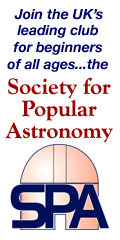The following is (or, rather, will be) a list of tools that I use when observing.
Sky-Watcher Explorer 130M
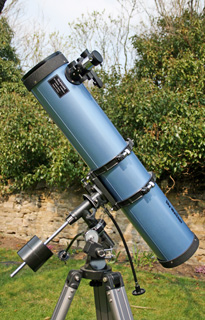 My current "primary" telescope is a Sky-Watcher
Explorer 130M.
It's a Newtonian
Reflector on an EQ2 mount with a motor drive for driving the mount in
right ascension. The primary mirror is 130mm (about 5.1 inches).
My current "primary" telescope is a Sky-Watcher
Explorer 130M.
It's a Newtonian
Reflector on an EQ2 mount with a motor drive for driving the mount in
right ascension. The primary mirror is 130mm (about 5.1 inches).
The choice of the 130M came about because I wanted something very affordable, relatively portable and of reasonable quality. This 'scope was one of the few that seemed to fit the bill.
It was purchased from South West Optics in March 2005.
So far I've been pretty happy with this 'scope. While I have had the odd problem this has mostly been down to my knowledge and abilities than down to any problems with the 'scope itself. I'd have no problems recommending it as a good beginner's telescope.
Antares 905
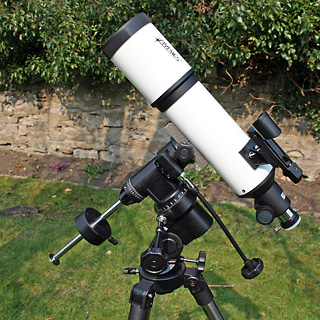 Early in 2006 I decided to treat myself
to a second telescope. This time I wanted something that would be more
portable than the 130M and which would, to some degree, fit inbetween using
a binocular and using the 130M. After a fair bit of looking about, in March
of 2006, I finally decided to try out the
Antares
905 as sold by
Scopes'n'Skies.
Early in 2006 I decided to treat myself
to a second telescope. This time I wanted something that would be more
portable than the 130M and which would, to some degree, fit inbetween using
a binocular and using the 130M. After a fair bit of looking about, in March
of 2006, I finally decided to try out the
Antares
905 as sold by
Scopes'n'Skies.
I've been very pleased with this 'scope given the intended purpose. For example, not long after getting it comet Schwassmann-Wachmann 3 was visible and the 905 served as a very handy tool for finding the comet fragmets and pin-pointing where they were before using the 130M to make observations.
Solarscope
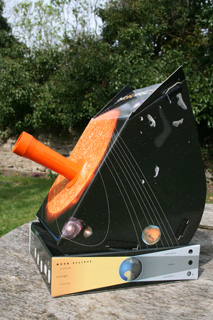 I purchased a Solarscope in anticipation of the
October 2005
Annular Eclipse (partial here in the UK although, sadly,
I didn't get to see it). It's a neat little tool that
allows for easy projection of the Sun without having to muck about with
telescopes, binoculars or pin-hole projection. One really nice thing about
the design is that the image is shaded from the Sun itself.
I purchased a Solarscope in anticipation of the
October 2005
Annular Eclipse (partial here in the UK although, sadly,
I didn't get to see it). It's a neat little tool that
allows for easy projection of the Sun without having to muck about with
telescopes, binoculars or pin-hole projection. One really nice thing about
the design is that the image is shaded from the Sun itself.
Despite buying this for the eclipse it's come in as a useful tool for general solar observing.
The only obvious downside to the Solarscope is that the telescope part is, obviously, right in the middle and so the image is projected back at the 'scope. This means you either have an obstructed image (as you can see in this observation) or you've got to angle things so that the Sun projects clear of the 'scope; in that case you end up with a distorted image.
Meade 10x50 Binolcular
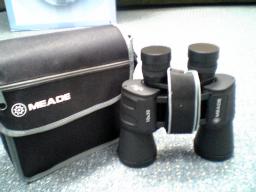 Purchased from Lidl of all places. They
were selling a load of them during Spring 2005 for £15.00 and, at that
price, how can you go wrong?
Purchased from Lidl of all places. They
were selling a load of them during Spring 2005 for £15.00 and, at that
price, how can you go wrong?
I always keep them in my observing kit bag because, no matter what other instrument I'm using, a binocular is essential kit and so simple to use.
I'd rate them as reasonable for astronomy. With bright objects there's a fair bit of flare on the image but other than that they're a joy to use. Very comfortable to hold and easy on the eye too.
Tento 10x50 Binolcular
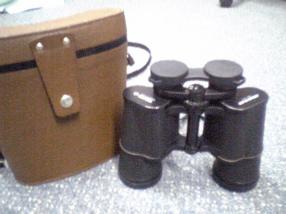 My "backup" binocular. I can't actually remember when I got these; probably
some time in the mid 1990s. They're Russian made and, like a lot of Russian
grear, they're tough and heavy.
My "backup" binocular. I can't actually remember when I got these; probably
some time in the mid 1990s. They're Russian made and, like a lot of Russian
grear, they're tough and heavy.
They're a little heavier than the Meade 10x50 and they're also a little harder on the eyes too (by that I mean the cups are a lot harder). They also seem to flare about as much as the Meade but in a slightly different way.
I find having two binoculars about very handy when I'm having a binocular session and when things are prone to fog up. When one binocular fogs up I just switch to the other while the first one clears.
Drawing Templates
 Most of the time, when I'm observing, I try and make sketches of the object
I'm looking at. To aid in making these sketches I created a set of simple
drawing templates using OpenOffice. These were nothing more than a set of
circles on an A4 sheet of paper which I then cut up and kept in my observing
kit bag.
Most of the time, when I'm observing, I try and make sketches of the object
I'm looking at. To aid in making these sketches I created a set of simple
drawing templates using OpenOffice. These were nothing more than a set of
circles on an A4 sheet of paper which I then cut up and kept in my observing
kit bag.
However, not being that satisfied with my first efforts, and after seeing the work of Jeff Stevens on the SPA's BBS, I decided to try and come up with something a little nicer.
Field Templates v2.pdf is the result.
General Information Folder
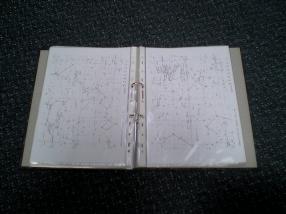 A simple yet very useful thing to have about. It's an A4 ring binder folder full of
A4 plastic folders (handy for keep dew off printed items). In it I've got things such as:
A simple yet very useful thing to have about. It's an A4 ring binder folder full of
A4 plastic folders (handy for keep dew off printed items). In it I've got things such as:
General information about my scope, the most useful being a table of the magnifications provided by eyepieces.
A laminated Messier map.
A laminated Caldwell map.
A printed copy of the Mag-7 Star Atlas.
A printed copy of the Wikipedia Messier Objects List.
Printed copies of my constellation charts.
I also keep a set of blank drawing templates in one of the plastic folders ready for use. Completed templates are put in another folder when a sketch has been done to protect them from dew (I tend to stick them into my logbook at the end of the session).
